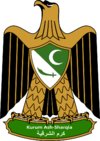Armorial of Kurum Ash-Sharqia
From MicrasWiki

——————————— Armorial of Kurum Ash-Sharqia ———————————
The armorial is managed by the Royal High Council of Genealogy and Heraldry.
Introduction
The heraldic traditions of Kurum Ash-Sharqia were inherited from New Batavia and its predecessor states. There is currently no law regulating the assumption, granting and inheritance of coats of arms and heraldic achievements.
In general, one can distinguish the following characteristics in Kurum Ash-Sharqian heraldry:
- Kurum Ash-Sharqian heraldry is reserverd for any person, regardless of social station (Burgherarms)
- Kurum Ash-Sharqian heraldry respects the rule of tincture
- Heraldic achievements are usually reserved for the nobility
- Heraldic crowns are used for displaying ranks of nobility
National coats of arms
| Coat of arms | Armiger | Registration | Notes |
|---|---|---|---|
| Sultante of Kurum Ash-Sharqia | 1733 AN | Adopted in 1700 AN. See also Coat of arms of Kurum Ash-Sharqia |
Coats of arms of towns and cities
| Coat of arms | Armiger | Registration | Notes |
|---|---|---|---|
Coats of arms of private persons, families and houses
| Coat of arms | Armiger | Registration | Notes |
|---|---|---|---|